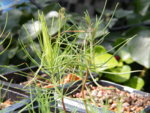It looked to retentive to me too, but it dries out in 3-4 days depending on weather. Which is the best I can manage. There's a bottom layer of coarse gravel and some 20 holes at the bottom of each tray.
Root growth is inhibited mainly by no roots being present, and the stems being eaten away in 4 days before callus formation even started. If there's no place to form roots, they wil not form. When left alone, what's left after 5 days (or 1 watering cycle) are 7 needles per cutting. The rest is just gone: eaten. Leave a cutting in water and it would probably live past that time.
For my red pines in the past and scots pines right now the first tray is still doing it's job. Somehow the worms seem to leave them alone.
I did some research on rooting behavior in the past. Because I wanted to root something that's just unrootable, unlayerable and couldn't be cultured in vitro.. Nor in vivo by the way, that plant was a "seed only" type of plant I had never experience before. Thanks Monsatan for making plants unsusceptible for auxins with your agent orange. Good job!
In established plants, dry moments cause vigorous root growth. In cuttings however, it doesn't exactly work in the same way.
Literature uses media compositions of around 96 or 97% or even 98% water for rooting media. And judging from a few years of experience in tissue culture, water content of a medium doesn't affect rooting a lot. We're talking about 2-5% differences in water content at most for very difficult rooting species, and an increase in rootability averaging around 2%, 15% in extreme cases.
In order of 'amount of effect' and importance:
1. Stress response (bleeding, tissue death)
2. Genetics (easy-rooting or not)
3. Cut site and size (below/above node, size of cutting)
4. Present foliage & season (some do better with, some without)
5. Age (younger tissue performs better)
6. Hormonal activity / bioactivity (auxins, cytokinins, abscissic acid)
7. Carbohydrate availability (too much = no roots, too little = no roots)
8. Nitrogen availability (too much = no roots)
9. pH
10. Water content (doesn't matter much, mostly affects disease susceptibility for waterbound infections, and vitrifcation)
Drying out and moving air does help prevent bacterial and fungal rot, that's a fact. I guess that would show by drooping needles, and the cuttings dying as a whole but equally. But it seems that isn't the issue here; the needles stay intact and some don't even look affected.. but at the mean time the stem is long gone.
Good observation though. It were those trays I did expect to stay too wet as well.














